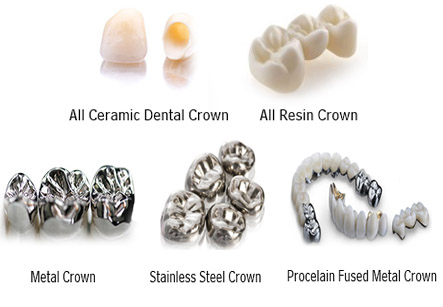Dental Crowns
Introduction
A dental crown is a cap placed over a tooth for restoring its shape, size, strength and also for improving its appearance. These crowns totally enclose the visible part of the tooth lying above the gum line after cementing.
Indications for a dental crown:
A dental crown is needed in the following conditions:
1. For protecting a week tooth from decay, from breaking or for holding parts of a cracked tooth.
2. For restoring broken or severely worn out tooth.
3. For supporting and covering a tooth with large filling.
4. For holding a permanent dental bridge between abutment teeth.
5. For covering a dental implant.
Iran offers a superior Dental treatments that is world best quality. For patients from the USA, and Europe for example, the savings can be 60% or more

Types of crowns:
Permanent crowns made up of all metal, porcelain-fused-to-metal, all resin, or all ceramic are available.
1. Metals: Dental crowns are made from gold alloy, palladium, nickel or chromium. For metal crowns, less tooth structure has to be removed. Metal crowns are longer lasting because they tolerate biting and chewing stresses well and are more resistant to wear and tear. Also, metal crowns rarely chip or break. But the main disadvantage is metallic color. Therefore they are a good choice for out-of-sight molars.
2. Porcelain-fused-to-metal: In this type, the color of the crown can be matched to adjacent teeth. But the drawback is that the opposite teeth are exposed to more wearing compared to all-metal crown. Also, there is a possibility that the porcelain portion of the crown can chip or break off. It gives more natural look than its all-porcelain counterpart. In some cases, the metal underlying the porcelain can show up through as a dark line. Particularly this happens at the gum line. These crowns are a good choice for front as well as back teeth.
3. All-resin: These are less expensive than other types of permanent crowns. But the wear and tear is more as compared to the porcelain-fused-to-metal crowns. Also, they tend to fracture.
4. All-ceramic or all-porcelain: These dental crowns are the best natural color match than any other crown type. Also, they are suitable for people having metal allergies. But, they are not as strong as porcelain-fused-to-metal crowns and they wear down the opposite teeth more than metal or resin crowns. All-ceramic type is more suitable for front teeth.
5. Temporary and permanent crowns: Temporary crowns are made in the dentist’s office itself after taking the impression. And permanent crowns are made in the dental laboratory from this model or impression. Temporary or makeshift crowns are made with the help of acrylic or stainless steel. They are used as a temporary restoration while waiting for a permanent crown to be made in the lab.
Tooth crown procedure:
1. The cosmetic dentist prepares an impression of the tooth and sends it to a dental laboratory to make the crown.
2. A temporary crown is given to the patient to wear till the permanent crown is ready.
3. After about two weeks, generally the crown is ready and the permanent crown is then cemented onto the tooth. Thus, only two visits are required for this procedure.
4. For stabilizing this structure, a filling is placed before placing a crown due to the loss of original tooth structure. The dental crowns have a running life of ten to fifteen years.
5. Make sure to discuss with the dentist about the color of the crown and also check whether it is same as temporary crown.
6. Sometimes, a flipper appliance is used in the place of temporary crown till the permanent crown is placed. A Flipper is a false tooth attached via either a wire or a plastic piece to the roof of the mouth awaiting the permanent crown.
Problems with a dental crown:
1. Sensitivity: Newly crowned tooth can be sensitive to extreme temperatures immediately after the procedure, as the effect of anesthesia begins to decrease. Too highly places crown can also cause sensitivity during bite. This can be corrected easily.
2. Chipping of crown: All porcelain crowns tend to chip. It is generally repaired by using a composite resin. But, if there is extensive chipping, the crown may need to be replaced.
3. Loose crown: Sometimes the cement washes under the crown gets dislodged causing loosening as well as infection. If a crown feels loose, contact the dentist.
4. Fall of the crown: Due to lack of cement or improper fitting. This can be fixed or replaced.
5. Allergy to metal or porcelain.
6. Cost of the crown must be weighed against the advantages.
On an average, life of the dental crown is about 15 years.